Beard Implants: Your Ultimate Solution for Facial Hair Growth
- Vita Hair Clinic

- Aug 7, 2024
- 20 min read
Updated: Jun 13, 2025
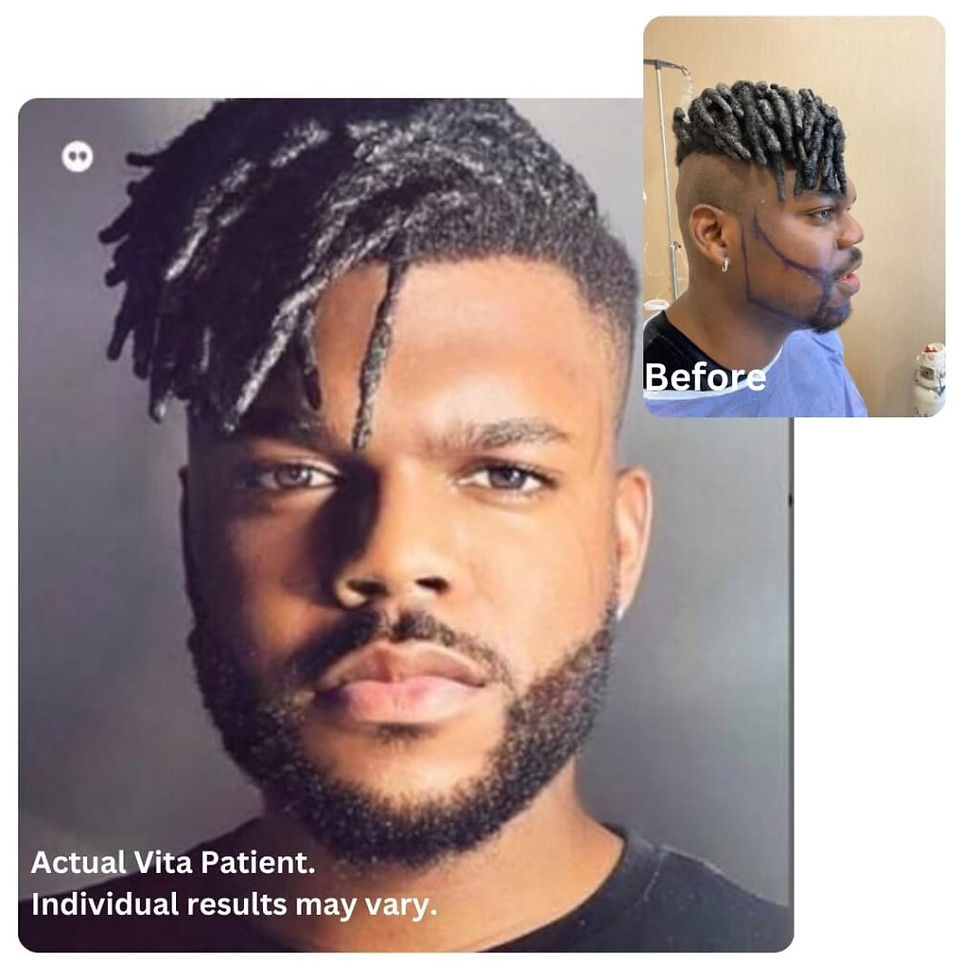
Introduction
Beard implants, also known as facial hair transplants, have emerged as a transformative solution for those struggling with inadequate facial hair growth.
This procedure, often referred to as facial hair surgery, addresses the concerns of individuals who experience patchy or sparse beard growth, offering a permanent and natural-looking enhancement.
Facial hair plays a significant role in personal presentation and confidence. A well-groomed beard can project an image of strength, maturity, and sophistication.
Conversely, the absence or irregularity of facial hair often leads to feelings of self-consciousness and frustration.
Research indicates that a lack of facial hair can erode one’s confidence, affecting daily interactions and overall self-esteem.
The process of hair transplant for facial hair involves relocating hair follicles from one part of the body to the face.
Understanding how this procedure works, including the technique used and the source of the transplanted hair, is crucial for anyone considering this life-changing option.
This procedure not only fills in gaps but allows for the sculpting of a desired beard shape.
Beard implants offer numerous benefits:
Natural appearance: The transplanted hair integrates seamlessly with existing facial hair.
Permanent results: Unlike temporary solutions, beard implants offer a lasting transformation.
Boost in confidence: Enhanced facial aesthetics contribute to improved self-assurance.
If you’re interested in exploring this transformative option further or have specific inquiries, feel free to contact us for more information.
We at Vita Estetic, led by our experienced specialist Dr. Kinyas Dusunmez, are committed to providing you with the best possible care and results in your journey towards achieving your desired facial aesthetics.
Understanding Beard Implants
Beard implants are a specialized type of hair restoration procedure designed to address the needs of individuals struggling with insufficient or uneven facial hair growth.
Using advanced techniques, beard transplants involve transferring hair follicles from one part of the body (typically the scalp) to areas on the face where growth is desired.
This method ensures a natural-looking and permanent enhancement to one’s beard.
Common Reasons for Seeking Beard Transplants
Individuals choose beard transplants for various reasons, such as:
Patchy Growth: Some men experience uneven or patchy beard growth due to genetics or hormonal imbalances. Beard implants can fill in these gaps, providing a fuller and more uniform appearance.
Trauma or Scarring: Injuries, surgical scars, or burns can prevent hair from growing in specific areas of the face. Beard transplants can effectively cover these scars and restore a natural look.
Aesthetic Preferences: For many, a thick and well-shaped beard is a symbol of masculinity and confidence. Those unable to grow such facial hair naturally may seek implants to achieve their desired look.
The Psychological Impact of Facial Hair
The presence or absence of facial hair can significantly influence an individual’s self-esteem and social interactions.
A well-groomed beard often enhances one’s personal presentation and instills a sense of confidence.
“Facial hair is not just about aesthetics; it plays a crucial role in how individuals perceive themselves and are perceived by others.”
Boosting Self-Esteem
Men suffering from patchy or sparse beards often report feelings of inadequacy or self-consciousness. Beard implants provide these individuals with an opportunity to reclaim their confidence:
Enhanced Appearance: A fuller beard contributes to a more mature and rugged look, positively impacting one’s self-image.
Positive Social Interactions: Increased confidence translates into better social engagements, whether in professional settings or personal relationships.
Key Takeaways
Definition: Beard implants involve transferring hair follicles to the face for improved facial hair growth.
Common Reasons: Addressing patchy growth, covering scars, and achieving aesthetic preferences.
Psychological Impact: Significant improvement in self-esteem and confidence through enhanced appearance.
Beard implants offer a transformative solution for those struggling with facial hair issues, blending physical enhancement with psychological benefits.
By understanding the purpose and impact of this procedure, individuals can make informed decisions about pursuing their ideal look.
For those considering this procedure, it’s beneficial to review before and after results which clearly illustrate the potential transformation.
It’s also important to note that beard implants can successfully address issues like a bald spot on the crown, which is often a concern for many men.
Moreover, hearing testimonials from previous patients can provide valuable insights into their experiences and outcomes after undergoing this procedure.
The Science Behind Beard Transplants
Beard transplants offer a revolutionary approach to achieving fuller facial hair. Understanding how they work reveals the meticulous science behind the procedure.
How Beard Transplants Work
Beard transplants involve transferring hair follicles from one part of the body to another. The process typically uses hair follicles from the scalp, which are ideal due to their similarity in texture and growth patterns to beard hair.
This technique is especially popular in places like Istanbul, known as the hair transplantation capital of the world, where affordable, high-quality procedures are performed by expert surgeons using advanced techniques.
The Role of Hair Follicles in Transplantation
Hair follicles are the fundamental units in this procedure. Each follicle contains a single hair, sebaceous gland, and surrounding supporting tissues.
For a successful transplant, it’s crucial that these follicles are harvested and implanted intact.
Identifying Donor and Recipient Areas
Donor Area: This is usually the back of the scalp, where hair is more resilient to balding. The selected follicles are carefully extracted to ensure minimal damage.
Recipient Area: The areas on the face where the beard is desired or needs thickening. Follicles are strategically implanted here to mimic natural growth patterns, ensuring a seamless blend with existing facial hair.
By understanding these key elements—how beard transplants function, the vital role of hair follicles, and how donor and recipient areas are identified—one can appreciate the precision required for optimal results.
Follicular Unit Excision (FUE) Technique: A Detailed Overview
The Follicular Unit Excision (FUE) technique has transformed beard transplant procedures by providing a minimally invasive method for graft implantation. This technique is preferred for its accuracy and effectiveness, ensuring natural-looking outcomes with little recovery time.
Detailed Explanation of the FUE Technique
FUE involves extracting individual hair follicles from a donor site, usually the back or sides of the scalp, and implanting them into the desired areas of the beard. The process unfolds in several meticulous steps:
Preparation: The donor area is shaved to facilitate the extraction of hair follicles. Local anesthesia is administered to ensure patient comfort.
Extraction: Using a micro-punch tool, each follicle is carefully removed from the donor area. The tool ranges in size from 0.7mm to 1mm in diameter, allowing for precise extraction without damaging surrounding tissues.
Graft Preparation: Extracted follicles are sorted and prepared under a microscope to ensure they are viable for transplantation.
Implantation: Tiny incisions are made in the recipient area following the natural pattern of beard growth. Follicles are then implanted one by one into these incisions.
This detailed approach allows surgeons to control the angle, depth, and direction of each implanted graft, resulting in a seamless integration with existing facial hair.
Advantages of FUE for Beard Transplants
The FUE technique offers several key benefits that make it an attractive option for individuals seeking beard transplants:
Minimally Invasive: Unlike traditional strip harvesting methods, FUE does not require large incisions, reducing scarring and promoting faster healing.
Natural Results: By implanting individual follicles with precision, FUE creates a natural appearance that closely mimics natural beard growth patterns.
Reduced Discomfort: Patients experience less pain and discomfort during and after the procedure due to its minimally invasive nature.
Short Recovery Time: Most patients can return to their normal activities within a few days post-procedure. Swelling and redness typically subside within a week.
Flexibility in Hair Styles: FUE allows for greater flexibility in styling as it enables detailed placement of grafts according to desired beard density and shape.
Recovery Process After FUE
Post-operative care is crucial to ensure optimal results from an FUE beard transplant. Here are some essential guidelines:
Immediate Post-Op Care: Patients should avoid touching or scratching the transplanted area in the first few days to prevent dislodging newly implanted grafts.
Cleaning Regimen: Gentle cleaning of the transplant site with prescribed solutions helps maintain hygiene and promote healing.
Avoiding Physical Strain: Strenuous activities should be avoided for at least a week post-surgery to minimize swelling and enhance recovery.
Sun Protection: Direct sun exposure should be limited as UV rays can affect healing and potentially damage new grafts.
Patients typically notice new hair growth within three months, with full results visible between 9 to 12 months post-transplantation.
The FUE technique represents a significant advancement in hair restoration—its precision, minimal invasiveness, and impressive results make it an excellent choice
Direct Hair Implantation (DHI): The Superior Option for Beard Transplants
Direct Hair Implantation (DHI) presents a cutting-edge approach to beard transplants, distinct from traditional methods like Follicular Unit Excision (FUE). This technique has emerged as a preferred choice among many due to its advanced methodology and numerous benefits.
Overview of the DHI Technique
The DHI technique involves the direct implantation of hair follicles into the beard area without the need for creating recipient sites beforehand. Here’s a step-by-step breakdown:
Extraction: Similar to FUE, hair follicles are extracted from the donor area, often the back of the scalp.
Preparation: The extracted hair follicles are kept in a special solution to enhance their viability.
Implantation: Using a specially designed tool called the Choi Implanter Pen, each follicle is implanted directly into the beard area. This pen allows for precise control over depth, angle, and direction of each follicle placement.
This method contrasts with FUE where recipient sites are created first and then hair follicles are inserted manually.
Benefits of DHI for Beard Transplants
The advantages of DHI make it an attractive option for those seeking beard transplants:
Minimal Scarring: Due to the precision of the Choi Implanter Pen, DHI results in significantly less scarring compared to other techniques. This is particularly advantageous for facial areas where skin visibility is high.
Quicker Recovery: Patients undergoing the DHI technique often experience faster recovery times. The minimally invasive nature of this method reduces trauma to the skin and promotes quicker healing.
Higher Survival Rate of Follicles: The special solution used during preparation increases follicle survival rates, ensuring better growth and density.
Natural-Looking Results: The ability to control implantation angles and directions ensures that transplanted hairs mimic natural growth patterns closely, resulting in a more authentic appearance.
Why Choose DHI?
Patients who opt for DHI often prioritize:
Aesthetic Excellence: With minimal scarring and highly natural-looking results, DHI ensures an aesthetically pleasing outcome.
Efficiency and Speed: The streamlined process not only shortens procedure time but also accelerates post-operative recovery.
Technological Sophistication: The use of advanced tools like the Choi Implanter Pen represents a leap forward in hair transplant technology.
Testimonials and Success Stories
Many have shared their positive experiences with DHI beard transplants.
For instance, Leon J. from Seattle attests to increased confidence post-procedure due to the natural look achieved through DHI at Vita Estetic Hair Transplant in Turkey.
The choice between FUE and DHI ultimately depends on individual preferences and specific medical advice.
However, the advantages offered by DHI often make it a superior option for those seeking optimal results in their beard transplant journey.
Preparing for a Beard Implant Procedure: What You Need to Know Beforehand
Importance of Choosing a Qualified Surgeon
Selecting a qualified surgeon is crucial for a successful beard implant procedure. An experienced surgeon ensures that the transplantation process is executed with precision, minimizing risks and enhancing the likelihood of optimal results.
Key criteria to consider when choosing a surgeon include:
Certifications and Training: Ensure the surgeon is board-certified in hair restoration or dermatology.
Experience: Look for surgeons with extensive experience specifically in beard transplants.
Patient Reviews: Examine testimonials and reviews from previous patients to gauge satisfaction rates.
Choosing a skilled professional can make the difference between a natural-looking beard and an unsatisfactory outcome.
What to Expect During the Initial Consultation
The initial consultation sets the stage for your beard implant journey. This meeting offers an opportunity for both you and your surgeon to discuss expectations, concerns, and procedural details. The consultation typically involves:
Health Assessment:
A thorough examination of your overall health to ensure you are fit for surgery.
Discussion of any underlying conditions that may affect the procedure.
Facial Hair Analysis:
Assessment of current facial hair growth patterns.
Identification of donor areas (usually the back of the scalp) where hair follicles will be harvested.
Personalized Treatment Plan:
Development of a tailored plan based on your specific needs and desired outcomes.
Explanation of the chosen technique (FUE or DHI) and why it is suitable for you.
Discussion of Risks and Benefits:
Detailed explanation of potential risks involved in the procedure.
Overview of expected benefits, including improved facial hair density and enhanced confidence.
Cost Estimation:
Transparent breakdown of costs including surgeon fees, facility charges, and post-operative care.
Pre-Operative Instructions:
Guidelines on how to prepare for surgery, such as avoiding certain medications or supplements that could affect healing.
During this critical phase, it’s essential to ask the right questions to ensure you’re making an informed decision about your procedure.
For instance, consider asking these important questions before surgery, which can provide clarity on various aspects related to your health and surgical procedure.
Making an Informed Decision
A well-conducted consultation empowers you with knowledge about the procedure, helping you make an informed decision.
Trust between you and your surgeon is vital; this initial meeting should instill confidence in their expertise and approach.
Moreover, understanding the principles that guide surgical practices can further bolster your confidence in making decisions related to your health.
Transitioning seamlessly into your preparation phase will ensure that you are well-informed, comfortable, and ready to achieve your facial hair goals with minimal stress.
Beard Transplant Costs: Understanding the Price Tag
When considering a beard transplant, understanding the price tag is crucial. Various factors influence the beard transplant cost:
1. Location
The geographical location of the clinic can significantly affect the price. For instance, a beard transplant in Istanbul tends to be more cost-effective compared to cities in Western Europe or North America.
2. Surgeon Expertise
The experience and reputation of the surgeon play a major role in determining costs. A highly skilled surgeon, such as those at Vita Estetic Hair Transplant led by Dr. Kinyas, may charge higher fees due to their expertise and success rates.
3. Technique Used
Different techniques come with varying costs. Advanced methods like Direct Hair Implantation (DHI) often have higher costs than traditional Follicular Unit Excision (FUE) methods due to their precision and quicker recovery times.
4. Number of Grafts
The extent of the procedure—how many hair follicles need to be transplanted—directly impacts the price. More extensive transplants with higher graft counts naturally incur greater costs.
At Vita Estetic, Beard Transplant in Turkey package prices vary based on several factors:
$2,000 for up to 1500 grafts using DHI techniques
$2,500 for up to 3000 grafts using DHI techniques
$3,000 for up to 4000 grafts using the latest DHI technique
Understanding these elements helps potential patients make informed decisions about their investment in beard hair transplant cost and achieve desired results.
Cost Comparison with Other Options: Is a Beard Transplant Worth It?
When considering facial hair restoration, it’s essential to weigh the benefits of surgical options like beard transplants against non-surgical alternatives such as minoxidil.
Understanding these solutions helps in making an informed decision that aligns with one’s goals and budget.
Surgical Options: Beard Transplants
Beard transplants offer a permanent solution to facial hair loss. Techniques such as Follicular Unit Excision (FUE) and Direct Hair Implantation (DHI) provide natural-looking results by transplanting hair follicles from one part of the body to the beard area.
Cost:
Typically, beard transplants can range from $2,000 to $17,000 depending on factors like the number of grafts required and the clinic’s location.
Benefits:
Long-lasting results: Since the transplanted follicles are your own hair, they continue to grow naturally.
Personalized outcomes: Surgeons can tailor the procedure to match your desired beard style.
Non-Surgical Alternatives: Minoxidil
Minoxidil is a topical treatment commonly used to stimulate hair growth. It’s available over-the-counter and can be applied directly to areas where you wish to enhance hair density.
Cost:
Minoxidil is significantly cheaper, generally costing between $20 to $60 per month.
Benefits:
Accessibility: Easily purchased without the need for surgical consultation.
Ease of use: Simple application process that can be incorporated into daily routines.
Comparing Effectiveness
Beard transplants guarantee lasting results with minimal maintenance once healed. In contrast, minoxidil requires continuous use to maintain any achieved gains.
If discontinued, any new growth may gradually diminish.
Permanent vs. Temporary:
Beard Transplants: Permanent solution with natural growth patterns.
Minoxidil: Temporary enhancement requiring ongoing use.
Investment in Confidence
While non-surgical options like minoxidil offer a cost-effective solution for those on a budget or seeking less invasive methods, they lack the permanence and predictability of surgical procedures.
Beard transplants, though more expensive upfront, deliver enduring results that profoundly impact personal confidence and daily presentation.
Choosing between these options depends on individual priorities—whether one values an immediate, low-cost approach or prefers investing in a long-term solution for facial hair growth.
Real-Life Transformations: Witnessing the Impact of Beard Transplants
Seeing real-life examples of successful beard transplants can provide a clearer understanding of what to expect from this transformative procedure. At Vita Estetic Hair Clinic, numerous patients have experienced life-changing results, regaining their confidence and achieving the facial hair they always desired.
Visual Evidence: Before and After Beard Transplant
Photographs showcasing before and after beard transplant results offer compelling evidence of the procedure’s effectiveness:
Case Study 1: A patient with a patchy beard achieved a dense and uniform look within months post-procedure.

Case Study 2: Another patient with minimal facial hair growth exhibited significant improvement in volume and coverage after transplant.

These transformations underscore the profound impact that beard hair transplant procedures can have on an individual’s life.
By trusting skilled professionals like Dr. Kinyas at Vita Estetic Hair Transplant in Turkey, patients can achieve natural-looking results that not only meet but often exceed their expectations.
Witnessing these real-life transformations reveals the potential of beard transplants to restore not just facial hair but also personal confidence and satisfaction in one’s appearance.
However, it’s important to understand that like any medical procedure, there can be concerns such as whether hair transplant is painful, potential hair transplant side effects, or what to expect after 10 years of having a hair transplant.
Expected Results After a Beard Transplant: What You Need to Know
Understanding the expected results after a beard transplant is crucial for setting realistic expectations and achieving patient satisfaction. The timeline for seeing results post-transplantation can vary, but typically follows a general pattern.
Timeline for Seeing Results
1. Immediate Post-Op (Days 1-7)
The initial week involves some redness and swelling in the transplanted area.
Tiny scabs will form around each transplanted hair follicle, which will naturally fall off within a week.
2. Early Growth Phase (Months 1-3)
Transplanted hairs may shed within the first month—this is a normal part of the process called “shock loss.”
New hair growth starts to become noticeable around the third month.
3. Growth Acceleration (Months 4-6)
A more significant amount of new hair begins to appear.
Hairs grow thicker and denser, gradually filling in previously patchy areas.
4. Maturation Phase (Months 7-12)
The beard continues to thicken, with most patients seeing substantial improvement.
By the end of this phase, the final results are generally visible.
Long-Term Results
Patient satisfaction is often high as the transplanted hairs are permanent, using your own hair follicles. This ensures that:
Natural Growth Patterns: The new beard grows naturally and blends seamlessly with existing facial hair.
Permanent Solution: Unlike temporary treatments, beard transplants offer long-lasting results.
Key Considerations
Ensuring optimal results requires attention to detail:
Post-Operative Care: Following prescribed care routines is essential for healing and successful hair growth.
Choosing Qualified Surgeons: Expertise directly impacts outcomes; selecting skilled professionals ensures higher success rates.
Patients who adhere to these guidelines often report not only improved aesthetics but also enhanced confidence, highlighting the transformative potential of beard transplants.
Post-operative Care After a Beard Transplant: Ensuring Optimal Healing
Proper post-operative care is crucial to ensure optimal healing and the success of your beard transplant. Following the right procedures can significantly impact the healing process, helping you achieve the best possible results.
Essential Care Tips for Post-Operative Healing
Cleaning Regimen
Gentle Washing: The first few days after surgery require delicate handling of the transplanted area. Use a mild shampoo and lukewarm water to gently clean the beard area without rubbing or scratching.
Pat Dry: Avoid using a towel to rub the face; instead, pat it dry with a soft cloth. This minimizes irritation and prevents dislodging the newly transplanted follicles.
Antiseptic Solutions: Your surgeon may recommend antiseptic solutions to keep the area free from infection. Follow their guidance on how often and how much to apply.
Avoiding Sun Exposure
Limit Outdoor Activities: Newly transplanted hair follicles are sensitive to UV rays. Limit direct sun exposure for at least one month post-surgery.
Use Sunscreen: If you need to be outside, apply a high-SPF sunscreen to protect the treated area. This helps in preventing any potential damage from harmful UV rays.
Managing Swelling and Discomfort
Cold Compresses: Apply cold compresses intermittently during the first 48 hours to reduce swelling and discomfort.
Elevation: Keeping your head elevated while sleeping can also help in minimizing swelling.
Pain Relief: Over-the-counter pain relievers, as recommended by your surgeon, can manage any discomfort during the initial recovery phase.
Monitoring for Signs of Infection
It’s essential to stay vigilant for any signs of infection during your healing process:
Redness and Heat: While some redness is normal, excessive heat or spreading redness could indicate an infection.
Pus or Unusual Discharge: Any unusual discharge from the surgical site warrants immediate medical attention.
Persistent Pain: Severe or persistent pain beyond what is expected should be reported to your healthcare provider promptly.
Follow-up Appointments
Regular follow-up appointments with your surgeon are vital in tracking your progress:
Initial Check-Up: Typically scheduled within a week after surgery, this visit allows your doctor to assess early healing and address any concerns.
Ongoing Assessments: Subsequent visits will monitor hair growth and ensure that no complications arise.
Lifestyle Adjustments
Implementing certain lifestyle adjustments can support optimal healing:
Avoid Smoking and Alcohol: Both smoking and alcohol can impede blood flow and delay healing. It’s advisable to avoid them before and after surgery.
Healthy Diet: A nutrient-rich diet supports overall health and promotes faster recovery. Focus on foods rich in vitamins A, C, E, zinc, and biotin.
Proper post-operative care is essential for achieving successful results from beard surgery. By following these guidelines diligently, you contribute significantly to a smooth healing process and attain the desired appearance with minimal complications.
Considering Your Options
While minoxidil offers a non-surgical route for enhancing facial hair growth, it may not provide the same level of density or permanence as a beard implant.
For those seeking immediate and long-lasting results, surgical options like Follicular Unit Excision (FUE) or Direct Hair Implantation (DHI) may be more suitable.
Understanding your goals and consulting with a qualified specialist can help determine the best approach for achieving your desired facial hair growth.
Lifestyle Changes That Can Support Facial Hair Growth
Dietary supplements play a crucial role in promoting healthy facial hair growth. Among these, biotin supplements are particularly noteworthy.
Biotin, also known as Vitamin B7, is essential for the production of keratin, a protein that forms the structure of hair. Regular intake of biotin can enhance hair strength and texture, making it an important supplement for those seeking fuller facial hair.
Key Supplements for Hair Growth
Biotin (Vitamin B7): Strengthens hair and promotes growth.
Vitamin E: Improves blood circulation to the scalp and face, supporting hair follicles.
Omega-3 Fatty Acids: Found in fish oil; promotes overall hair health.
Nutritional Tips
Incorporating a balanced diet rich in vitamins and minerals can significantly impact facial hair growth:
Proteins: Essential for hair structure; include lean meats, eggs, and legumes.
Zinc: Found in nuts and seeds; vital for tissue growth and repair.
Iron: Enhances oxygen flow to hair follicles; available in spinach and red meat.
Maintaining a healthy lifestyle extends beyond diet. Regular exercise boosts circulation, ensuring nutrients reach hair follicles efficiently. Adequate sleep and stress management also contribute to optimal hair health.
Consistently following these practices not only supports facial hair growth but also enhances overall well-being.
Choosing the Right Clinic for Your Beard Implant Procedure
Selecting the right clinic for your beard implant procedure is critical for achieving optimal results. The success of the transplant largely depends on the expertise of the surgeons and the quality of care provided by the clinic.
Key Criteria When Selecting a Clinic
1. Surgeon Qualifications
When finding qualified surgeons for beard transplants, consider:
Board Certification: Ensure the surgeon is board-certified in hair restoration or a related field.
Experience: Look for a surgeon with extensive experience specifically in beard transplants. A surgeon like Dr. Kinyas from Vita Estetic Hair Transplant, with over 11 years of experience, exemplifies the level of expertise needed.
Continuous Education: Surgeons who regularly attend workshops, courses, and conferences are more likely to be updated with the latest techniques and innovations.
2. Success Rates
A high success rate is indicative of a clinic’s proficiency. Evaluate this by:
Patient Testimonials: Read reviews and testimonials from previous patients. Positive feedback from individuals like Leon J. from Seattle, WA, who increased his confidence significantly after his procedure at Vita, can be quite telling.
Before-and-After Photos: Reviewing photographic evidence of past surgeries provides a visual confirmation of the clinic’s capabilities.
Satisfaction Guarantees: Clinics offering guarantees or free replacements for non-growing grafts demonstrate confidence in their work.
Additional Considerations
3. Technique Specialization
Different clinics may specialize in various techniques such as Follicular Unit Excision (FUE) or Direct Hair Implantation (DHI). It’s essential to choose a clinic that offers the technique most suited to your needs.
For instance, Vita Estetic offers packages using both older techniques and the latest DHI method, ensuring personalized solutions.
4. Personalized Consultation
A reliable clinic will offer a thorough initial consultation to discuss your goals, examine your facial structure, and determine the most suitable approach for your beard transplant.
This step is crucial for setting realistic expectations and crafting a personalized treatment plan.
5. Post-Operative Care
High-quality post-operative care is vital for ensuring proper healing and maximizing transplant success. Select a clinic that provides comprehensive aftercare instructions and support throughout your recovery period.
6. Cost Transparency
While cost should not be the sole deciding factor, it’s important to understand what you’re paying for:
Breakdown of Costs: Ensure there is clarity on what each part of the procedure entails.
Value for Money: Assess whether the cost aligns with the level of expertise and care provided.
Selecting a reputable clinic that meets these criteria will enhance your chances of achieving a natural-looking and long-lasting beard transplant.
Why Choose Turkey as Your Destination for a Beard Transplant?
Turkey, especially Istanbul, has become a top choice for beard transplants. Here are some reasons why it’s a great option:
Cost-Effectiveness
One of the biggest advantages is the cost-effectiveness. The cost of beard transplant in Turkey usually falls between $2,000 to $5,000, which is much lower compared to prices in the US or Western Europe. This affordability doesn’t compromise quality, making it a highly sought-after option.
Quality Clinics and Expertise
Turkey has many world-class clinics specializing in hair restoration. Clinics like Vita Estetic Hair Transplant offer personalized and natural-looking results with over 11 years of experience. Led by experts such as Dr. Kinyas, these facilities ensure high success rates and patient satisfaction.
“Vita guarantees fabulous hair and 3x more confidence with a 99% satisfaction rate.”
Experienced Surgeons
The country is home to some of the most skilled surgeons in the field. These professionals are proficient in both Follicular Unit Excision (FUE) and Direct Hair Implantation (DHI) techniques, ensuring optimal outcomes for patients.
Comprehensive Packages
Clinics in Turkey often provide all-inclusive packages that cover accommodation, transportation, and post-operative care. This holistic approach simplifies the process for international patients, making the experience seamless.
Guaranteed Results
Institutions like Vita Estetic offer guarantees to replace any non-growing hair transplant grafts free of charge, underscoring their commitment to patient satisfaction.
Choosing Turkey for your beard transplant combines affordability with exceptional quality care, making it an ideal destination for those seeking effective facial hair growth solutions.
For detailed information on costs and options:
Search for “beard transplant Turkey”
Explore “Istanbul options”
compare beard transplant cost in turkey
FAQs (Frequently Asked Questions)
What are beard implants and how do they work?
Beard implants, also known as facial hair transplants, are a surgical procedure designed to restore facial hair growth in areas where it is sparse or absent.
The process involves harvesting hair follicles from a donor area, typically on the scalp, and implanting them into the recipient area of the beard.
This technique helps individuals achieve a fuller and more aesthetically pleasing beard.
What factors influence the cost of a beard transplant?
The cost of a beard transplant can vary significantly based on several factors, including the location of the clinic, the expertise of the surgeon performing the procedure, and the specific techniques used (such as FUE or DHI).
Additionally, costs may differ between countries, with Turkey often being recognized for its cost-effective options without compromising quality.
What is the difference between FUE and DHI techniques for beard transplants?
FUE (Follicular Unit Excision) is a method where individual hair follicles are extracted and then implanted into the beard area. DHI (Direct Hair Implantation), on the other hand, allows for immediate implantation of harvested follicles using a specialized tool that minimizes scarring and promotes quicker recovery.
Both techniques have their advantages, but DHI is often preferred for its efficiency and reduced healing time.
What can I expect during my initial consultation for a beard transplant?
During your initial consultation for a beard transplant, you will meet with a qualified surgeon who will assess your facial hair growth patterns and discuss your aesthetic goals.
The surgeon will explain the procedure in detail, evaluate your medical history, and address any concerns you may have regarding risks and recovery.
This is also an opportunity to ask questions about costs and expected outcomes.
How long does it take to see results after a beard transplant?
After undergoing a beard transplant, patients typically begin to see noticeable results within three to six months as the newly implanted hair follicles start to grow.
However, full results may take up to a year to manifest as hair continues to mature and thicken over time. Patient satisfaction rates are generally high once these results are achieved.
Are there non-surgical alternatives to enhance facial hair growth?
Yes, there are non-surgical alternatives available for enhancing facial hair growth.
Topical treatments such as minoxidil (commonly known as Rogaine) have been shown to promote hair regrowth in some individuals.
Additionally, dietary supplements like biotin may support overall hair health.
However, these options may not provide the same dramatic results as surgical procedures like beard transplants.
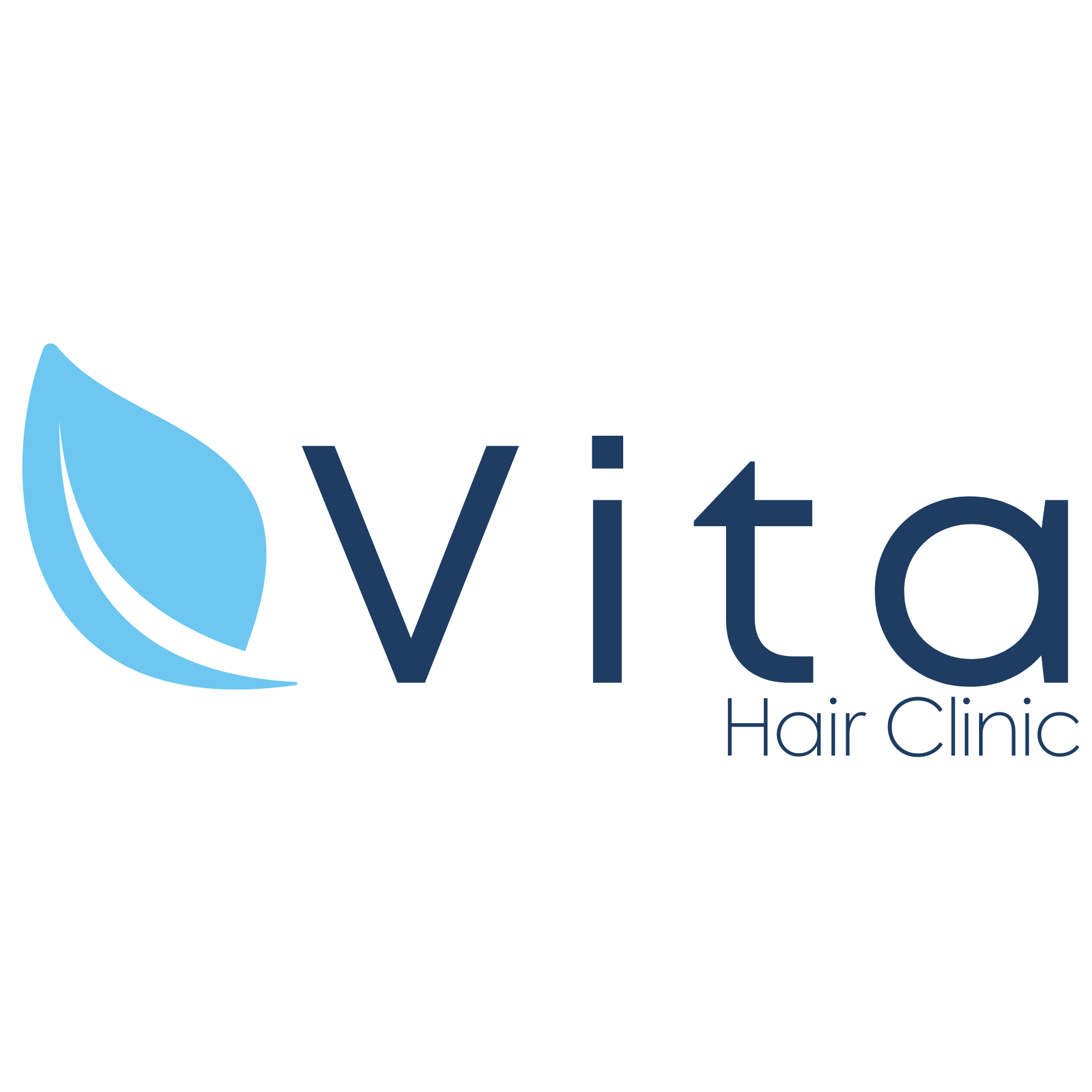
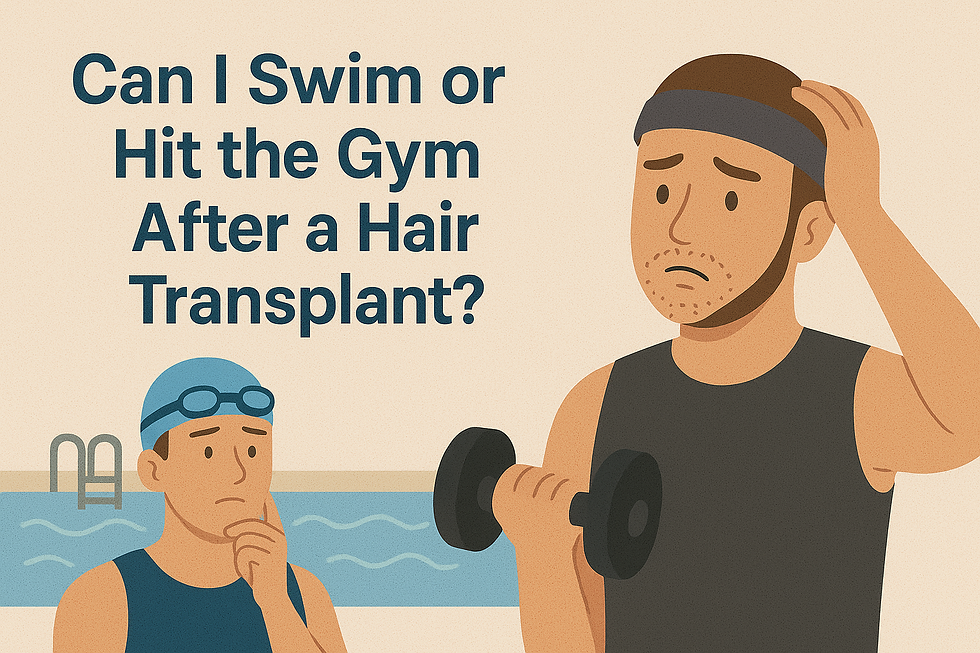
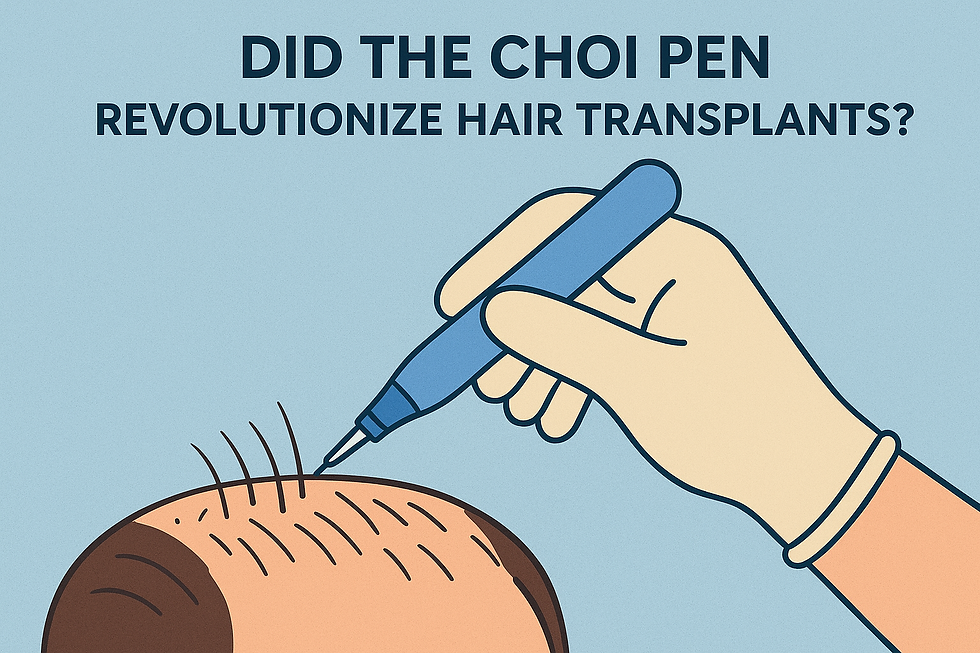







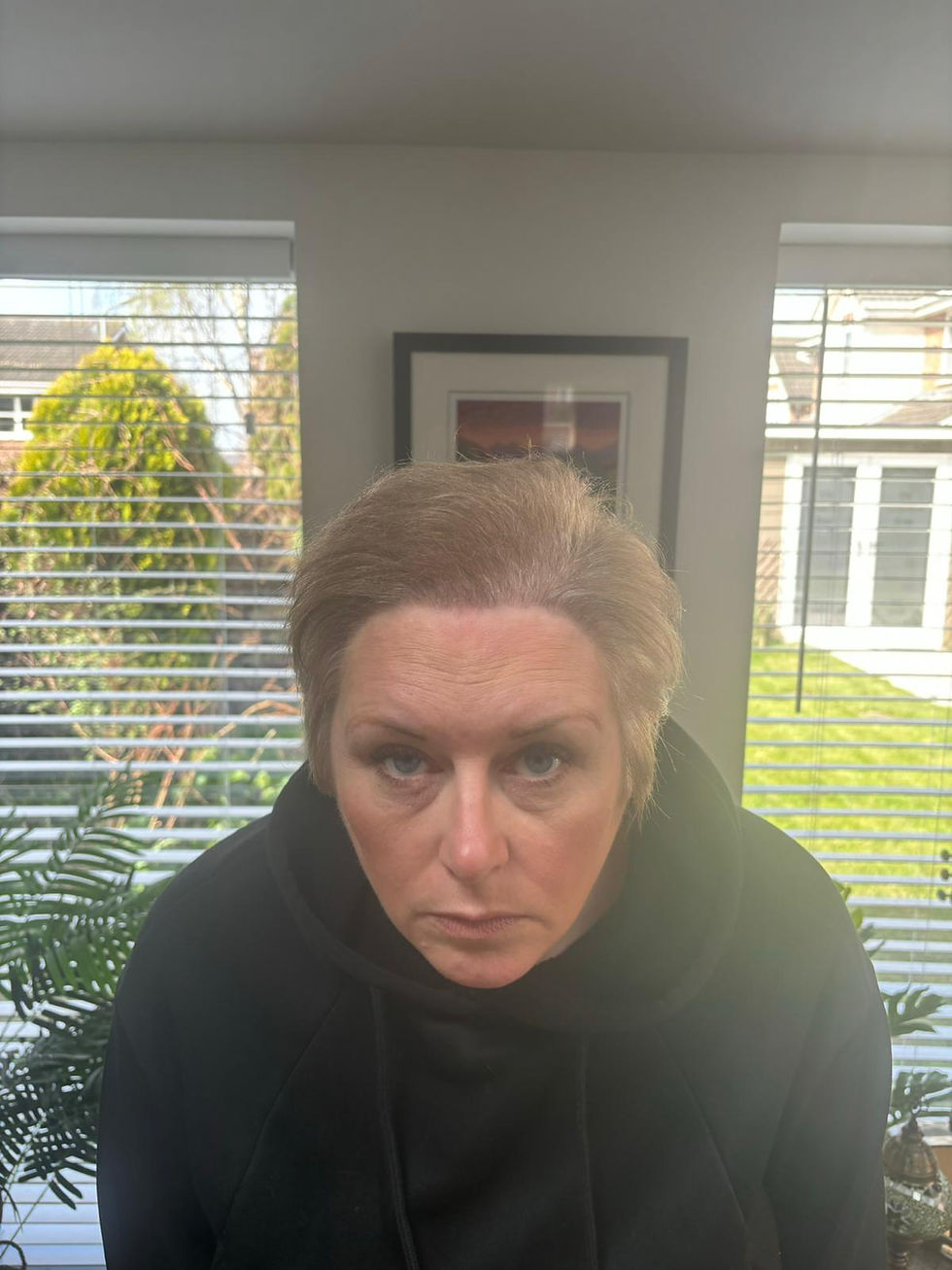

.png)
Comments